How to can tomatoes: Lucille’s method
In a post I wrote last week, I promised that I’d share with you the method by which I can my tomatoes, and since I am a woman of my word, that’s what I’m going to do. To wit.
When I was a much younger thing (ahem), I was floundering about, trying to decide the best way to put up my tomato harvest. I was a little afraid of the pressure canner (still am) and yet there were all these “official” recommendations about not using the water-bath method any longer, in canning tomatoes. The open-kettle method, from all my searching, was just one step better than intentionally poisoning yourself.
I called the county extension office. The lady who answered the ‘phone assured me that they no longer recommended the “open kettle” method, and if I didn’t use the pressure canner that I needed to boil my jars in a water bath for 1 hour and 45 minutes. I couldn’t believe that was necessary! “How could any nutrients be left in the tomatoes after that treatment?” I sputtered. “That’s my official advice,” she muttered.
I sensed something in her answer. “What do you do with your tomatoes?” I asked. “Unofficially?”
“I use the open kettle method,” she said, “Always have . . . but I can’t tell you that officially.”
I thought she was hiding something. Hmph. Such intrigue in the county extension office, I never would have guessed!
I consulted many other sources and talked to lots of different people, all while the tomatoes in my garden ripened and accumulated. I was confused by all the varied recommendations, and because I was quite a bit younger then, I was also intimidated by them, too. But . . . I’m one of those people that stubbornly tends to forge my own path. Not, of course, that I want to poison anybody. What was best? And what, really, was necessary?
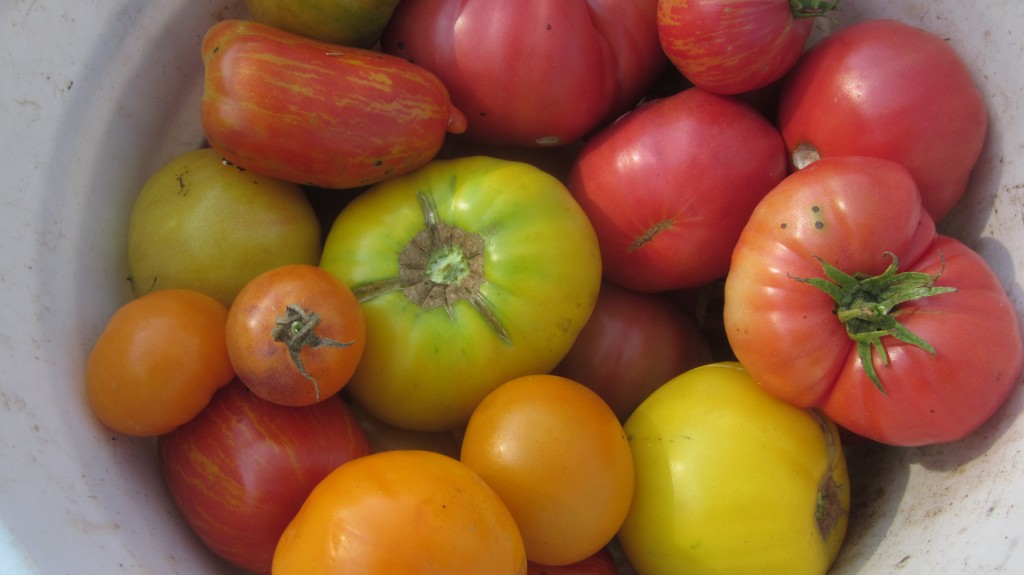
Oh, lovely and abundant tomatoes, whatever shall I do with you—??
Mind you, sometimes my independent thinking (good husband Bryan would probably call it something else, a word that starts with “st” but what does he know, really?) works out well, sometimes not. (We won’t talk about the “not” episodes.)
But in this case, I veered away from conventional wisdom (i.e. the “on the record” advice of the county extension agent, and the advice of several canning books) and went with the common sense advice of a Mennonite woman in our community, Lucille. I struck up a conversation with her while I was standing in the check-out line of the grocery store.
What she said made so much sense. And she assured me that she had been canning tomatoes this way for over 50 years and had never poisoned anybody. Not once! “What about heirloom tomatoes?” I asked. “Honey, when I started raising tomatoes,” she assured me, “they were all heirlooms.” That was enough for me. Folk wisdom over official government-sanctioned wisdom always rules the day for me. Obviously.
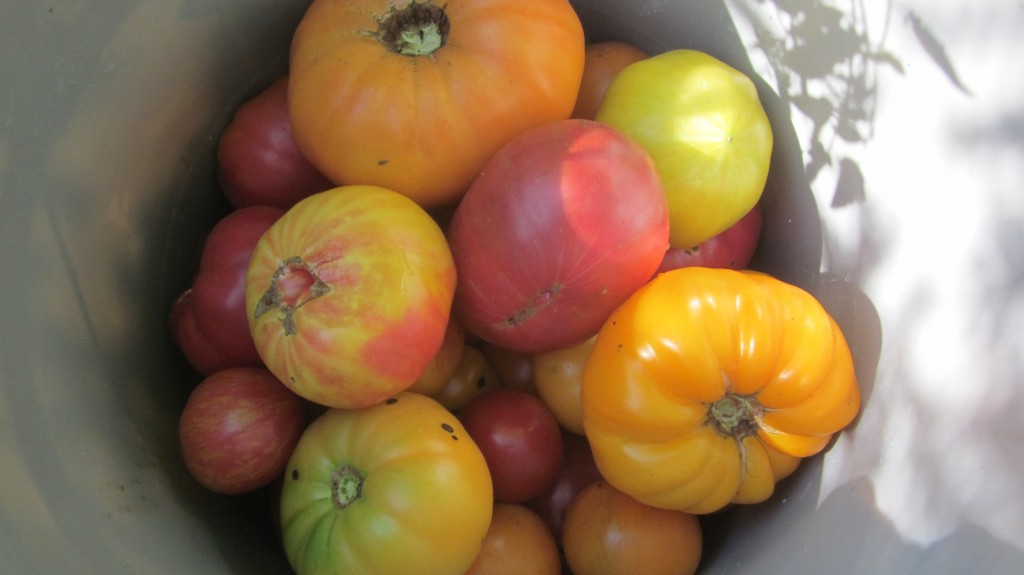
I simply can’t raise “just” red tomatoes, when there are so many pretty colored varieties available. Yellow–pink–striped–green!!
I realize that you may not want to take this leap of faith, Gentle Reader, and that’s okay. Everybody seems to have their own strongly-held opinion on tomato-canning methods. So go with what you have decided is the best way, Gentle Reader.
Naturally it would be foolish to follow anybody blindly–even me–especially me!!–without doing your own research, first. Right? Of course, right!
So here’s what happened the other day, as my daughter Amalia and I prepared to can tomatoes. Amalia had other things to do that day–can you imagine–and so, as a matter of fact, did I, so we decided to see how quickly and efficiently we could actually accomplish this task, the two of us.
I told my daughter that I was going to jot down notes, to turn into this blog post, later, when I felt like sitting for a spell. “This’ll be fun!” I enthused. “Like a science experiment. We’ll be focussed–single-minded–and we’ll go straight from picking to processing, to canning, just to see how quickly to do it. Game?”
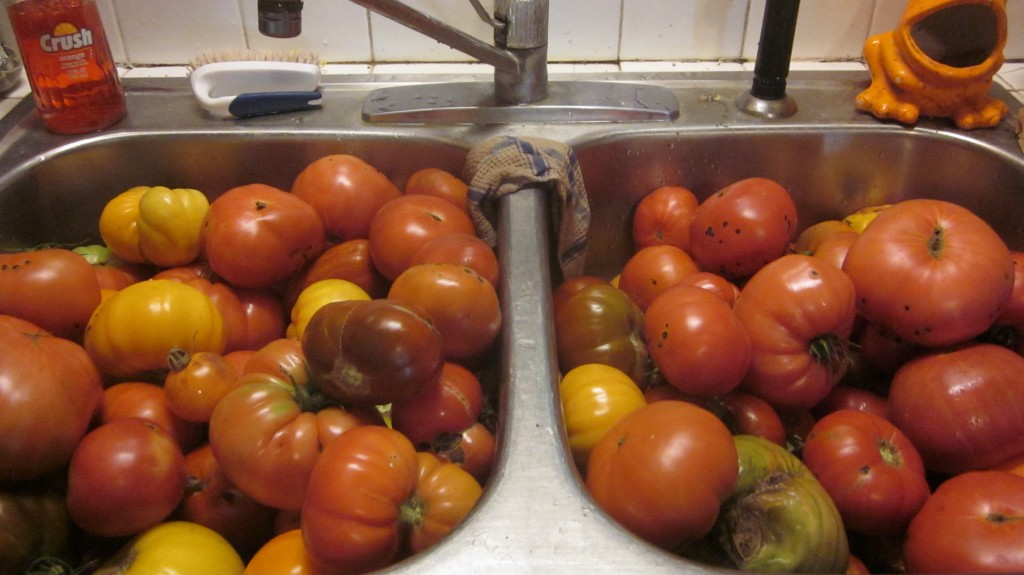
Such bounty!
My daughter is a good sport, and the idea of taking as little time as possible to do this routine fall chore appealed to her. I had already picked the tomatoes.
I loaded the tomatoes into my kitchen sink and looked at the clock. “Nothing will interrupt us. Here we go. It’s 10:00,” I said. I made a note. “10:00. Begin washing tomatoes.”
We both sprung into action. I filled a big pot on the stove with water, for scalding, and Amalia got a big bowl of ice water on the counter top, for peeling skins. I found a good paring knife. Amalia put on music and found another big bowl for the skinned tomatoes to rest in, before being transferred to the big stock pot on the stovetop.
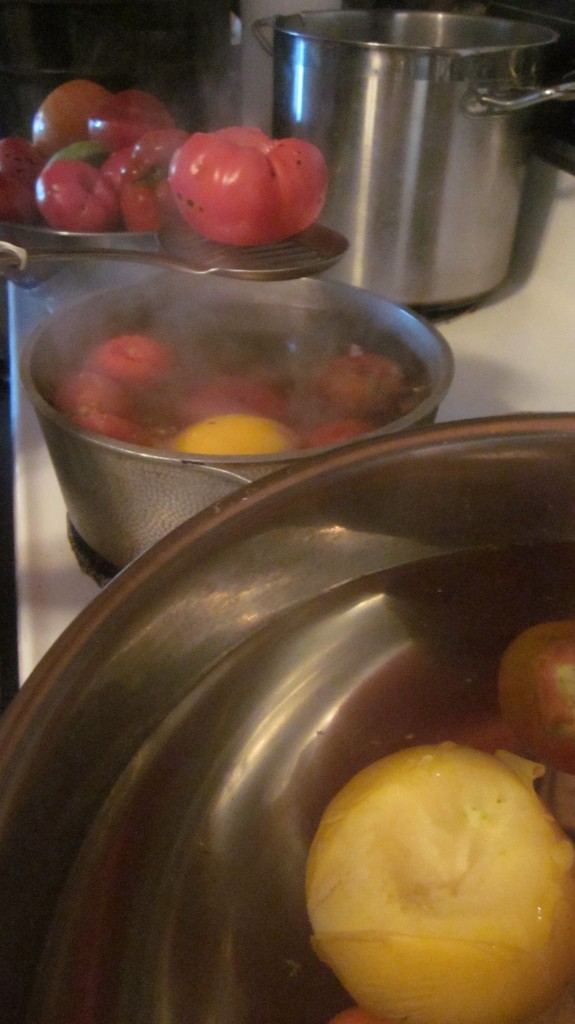
Here’s our scalding set-up: a pot of boiling water on the stove, and a big bowl of ice water for plunging. You can see the skin splitting on the yellow tomato in the foreground.
“10:05,” I jotted down. “Set up prep station.” I got started coring the tomatoes, and when I had a bowlful, I’d hand them to Amalia, who would dip them into the boiling water for a minute or two, or until the skins split. Then she’d pull them out and plunge them into the ice water.
It was only 10:15 when we had our first interruption. Little Mack came into the kitchen. “Dad said could you send out some clean cheesecloth,” he said.
Oh boy. Bryan had chosen this day to take the honey off the bees, too, and the cheesecloth for the spigot of the honey extractor is an item that doesn’t exactly have its own place in our kitchen, since we only need it once a year. I grabbed a chair and started scrabbling about in the upper cupboards, trying to find the leftover cheesecloth from last year. I knew that if I couldn’t find it, that one of us (probably me) would have to run to the store for some. Please let there be leftover cheesecloth . . . please . . I found it!
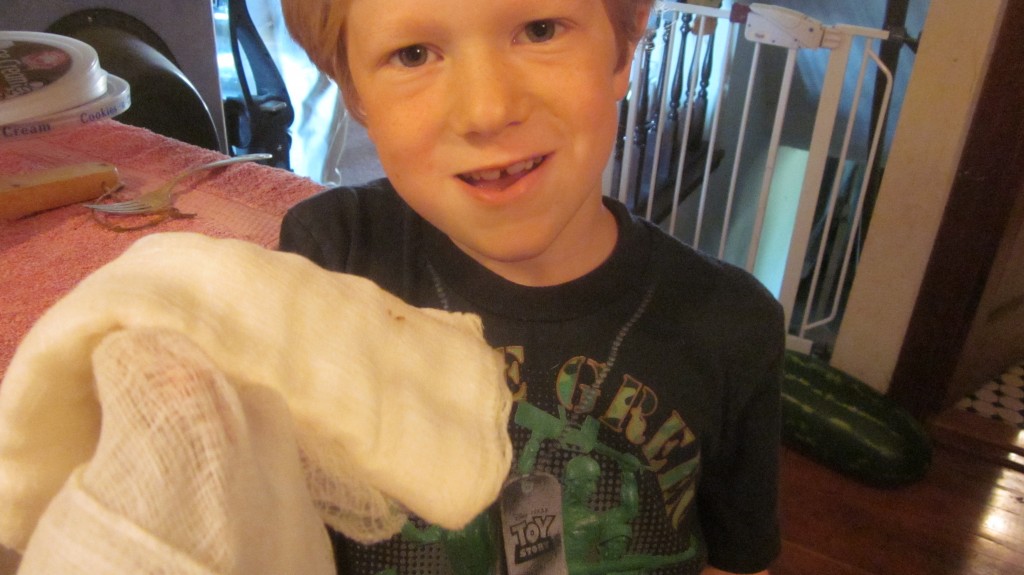
Success! Found it!
Amalia and I got right back to work. I cored and cut out bad spots at the sink, and then handed her bowlful after bowlful, which she then scalded and plunged into the ice water, and then I skinned and cut up and transferred to the stock pot. We had a definite rhythm going. We were making great time.
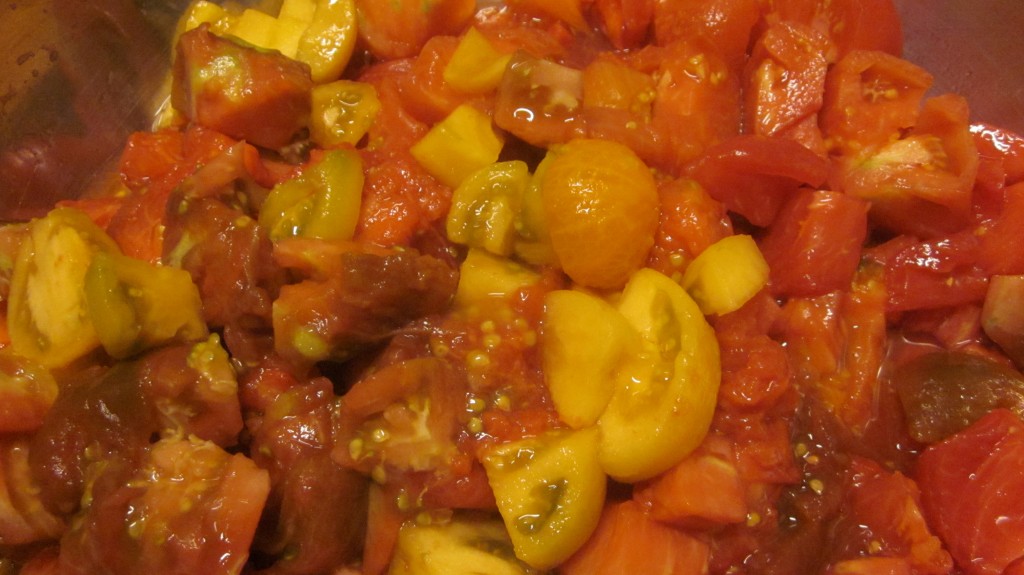
Here are the tomatoes all skinned and cut up into chunks and ready for the stock pot.
It was about 11:15 when we had the large stock pot full of tomatoes, though it wasn’t boiling yet. We had another pot on the stovetop, full of water to sterilize the jars, and another, smaller saucepan with the lids. I turned the heat up underneath the tomatoes, waiting for it to come to a boil, and gave it a few stirs. “We could have these ready for the jars by noon, honey!” I noted to my daughter.
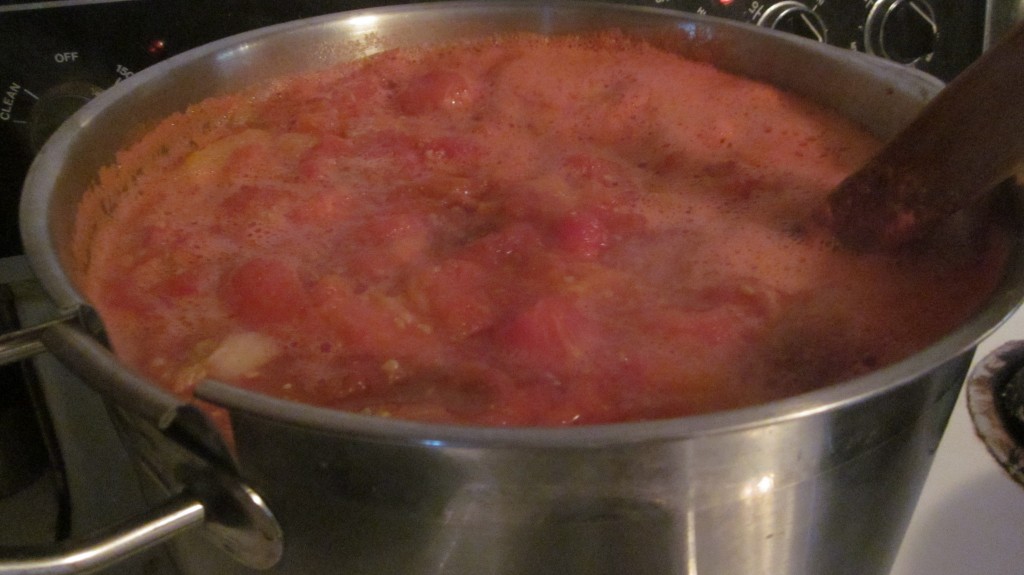
Here’s my stockpot, nearly boiling over with goodness.
It sounds like so much trouble to can tomatoes, but I wanted to demonstrate to myself (and to my daughter) that it didn’t take so long to do it, if you have your system down. . . and if you have a willing helper it’s great, too . . .
I turned the heat up underneath the potful of tomatoes and took a few stirs. It was starting to smell lovely. Amalia continued to work on the tomatoes. It looked like we’d have a potful and another half potful before we were finished.
“Dad says come look at the honey, Mom!” little Mack said, poking his head into the kitchen. “11:15. Went to admire the honey.”
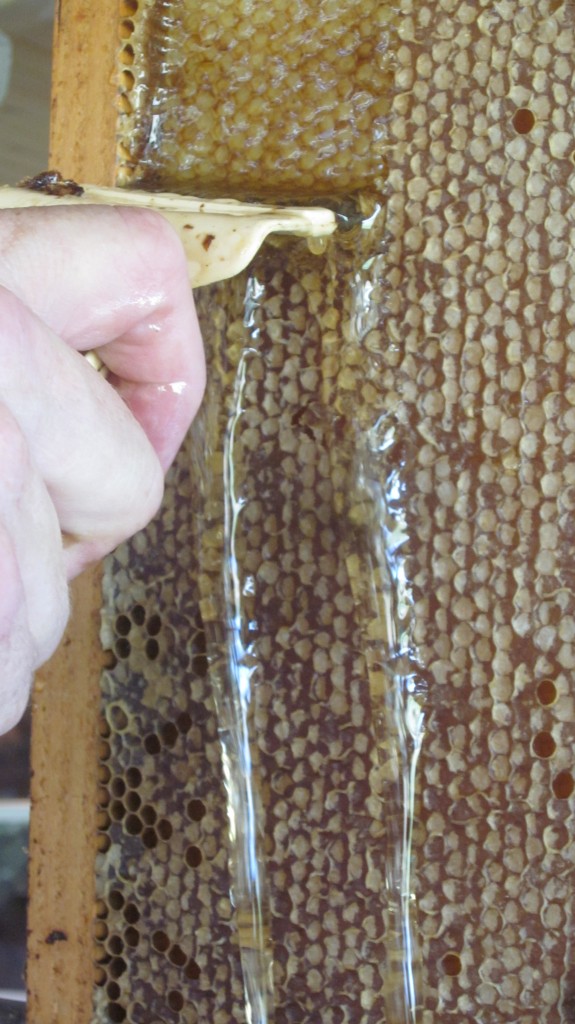
Here’s the first super of honey, as Bryan begins to scrape it off its frames. Yum.
Oh, it was so beautiful, it was certainly worth the pause in our progress to admire it. And to take a few tastes. And to chat with Bryan about its general quality and goodness. And to remind myself of how blessed I am, that we have a healthy hive of honeybees that make this absolutely miraculous sweet for us each and every year. Well, not every year, actually.
Because of pesticide use and certain pesticides in particular and GMOs and other man-generated environmental factors, we can’t always count on this. We lose at least half our hives every year. I think this is just very, very sad, and I hope that somebody does something about it before long. We need our bees.
I was mulling this over in my mind, when I smelled something. Something, perhaps, possibly, a bit scorched, or . . . something.
You think I’m going to say that I burned the tomatoes at this point, don’t you? But no. The pot full of tomatoes had started boiling and some had splashed out on the burner. Phew! I’ve actually ruined an entire stockpot of tomatoes before, but that was before my Dad took pity on me and my thin-bottomed stock pot that I used at the time and bought me a decent one with a substantial bottom. (No human parallels here, please!)
We were cleaning up the counter and feeling pretty smug about our progress, the tomatoes bubbling away nicely, when Bryan came into the kitchen. “Hey–ya wanna let me take you out for lunch?” he asked. I looked at the clock. I looked at my pitiful sheet full of notes. I looked at me bubbling pot full of tomatoes. I looked at my husband.
“Sure,” I said. Lunch out always trumps attempting a tomato-canning speed record, don’t you agree? So I turned off the burner underneath the stockpot, and washed up and went out to lunch.
Oh well. When we got home, our son Andrew and nephew Davey arrived to do some work on a web project with our son Timothy. Here’s Milford’s newest creative braintrust: Milford doesn’t even know that this team exists yet, but it will. Oh yes. It will.
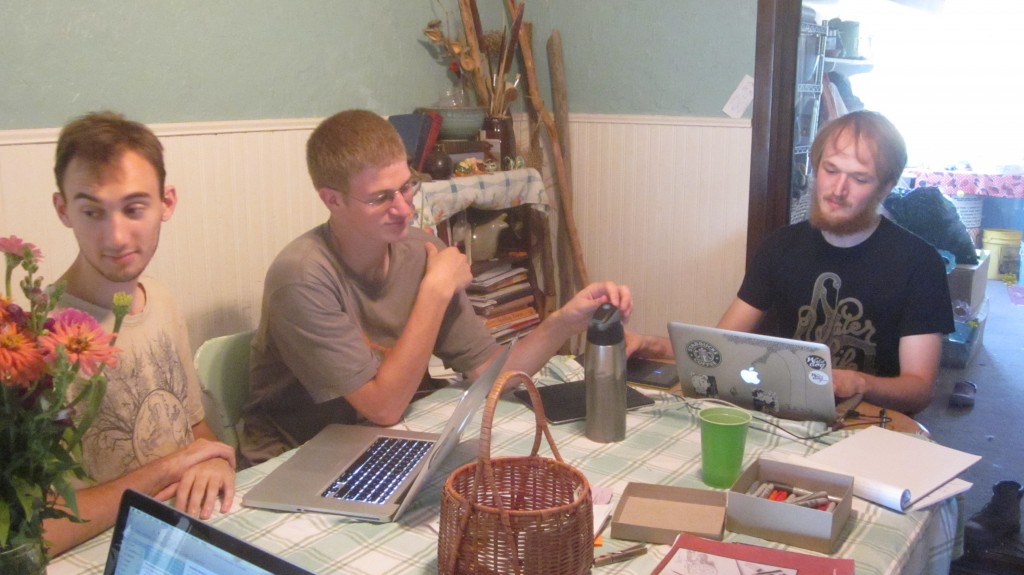
I turned the burner back on, and brought the tomatoes to a boil. While they boiled, I got jars ready, visited with the brain trust, and cleaned up the kitchen. I wasn’t making good time any more, but I didn’t really care.
Once the tomatoes had boiled for half an hour, I put them into jars.
By the way, I just bought this book (full of tantalizing recipes like “Carrot Cake Preserves” and “Ginger whatwhat” and “Dilly whatnot”) and I just love it. If you do some canning every year and don’t have a good all-purpose canning book, this one is a great resource!
You might want to add it to your kitchen library, too! Then if you have way too many carrots in your garden to eat, or your family is getting tired of corn-on-the-cob every stinkin’ meal, but you don’t want to let your sweet corn harvest go to waste, you’ll have a number of great ideas for how to preserve them.
This book is wonderful, too. My daughter-in-law Rachel has it and I enjoyed reading through it the last time we were visiting in St. Louis. She embodies the next generation of canners, and a joyful and creative lot they are! (I want to buy this book as soon as I can justify another book purchase.)
So back to the tomatoes, shameless product plant aside. By the way, in a shameless attempt to make a few pennies off my blog, I am an affiliate of Amazon.com (you may have heard of this little company) so if you click on the link above to buy your book, I’ll make a bit of cash which I’ll turn around and buy more canning jars with! Or a package of lids. Or some canning salt. Something. Anyway.
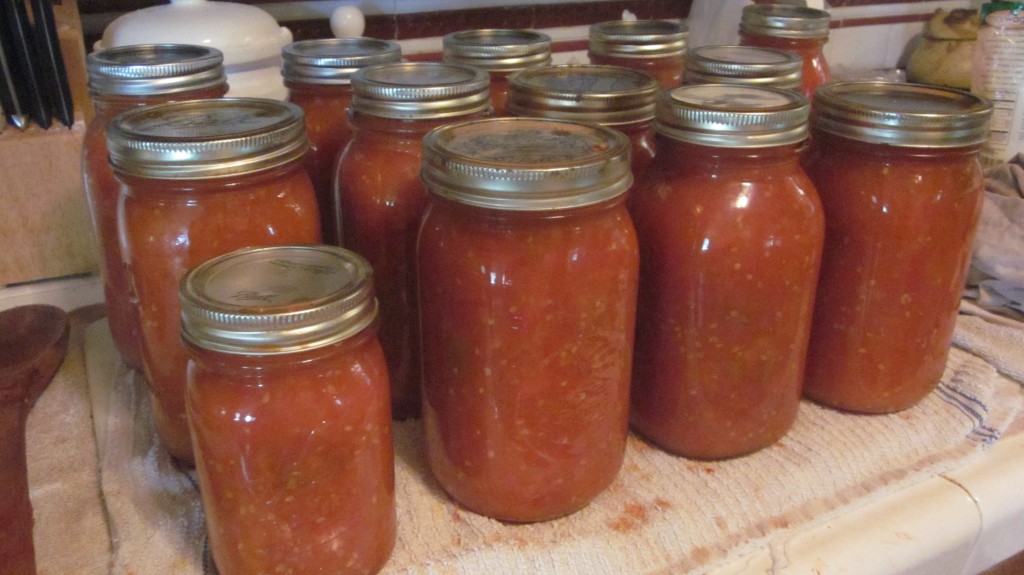
Isn’t this a lovely sight?
So to make a long story not quite so long, we ended up with 12 and a half quarts of absolutely beautiful canned tomatoes, but not a canning-speed record, by a long shot. We’ll try for that another time. We stopped to taste honey, visit with creative folks, and find items for short people, and that’s okay. I think I answered the ‘phone in there a few times, too, for good measure.
Now for the real reason I wrote this post: Here is how I can my tomatoes, in an easy-to-read list. Before you try it for yourself, though, familiarize yourself with basic canning methods, which you can find just about anywhere.
- Wash, scald, peel, and chop tomatoes
- Bring to boil in large thick-bottomed (watch it!) stock-pot and stir occasionally, 30 minutes.
- Sterilize jars and lids.
- Pull one jar at a time out of the boiling water. Add 1 Tb. vinegar and 1 tsp pickling salt, and pour in boiling tomatoes. Leave 1/2″ headspace and seal. Screw on rings firmly.
- Let your jars cool and sit for 24 hours.
- Check jars for sealing, and if any don’t seal, refrigerate and use within a day or two.
That’s it! It’s not so difficult, after all, is it, Gentle Reader? That’s just one thing you can do with your tomato harvest, and canned tomatoes are a wonderful base for chilis and soups and spaghetti sauces and whatnot. They are a meal-starter in a jar! We’ll be making some roasted tomato sauce later this week, and so check back!
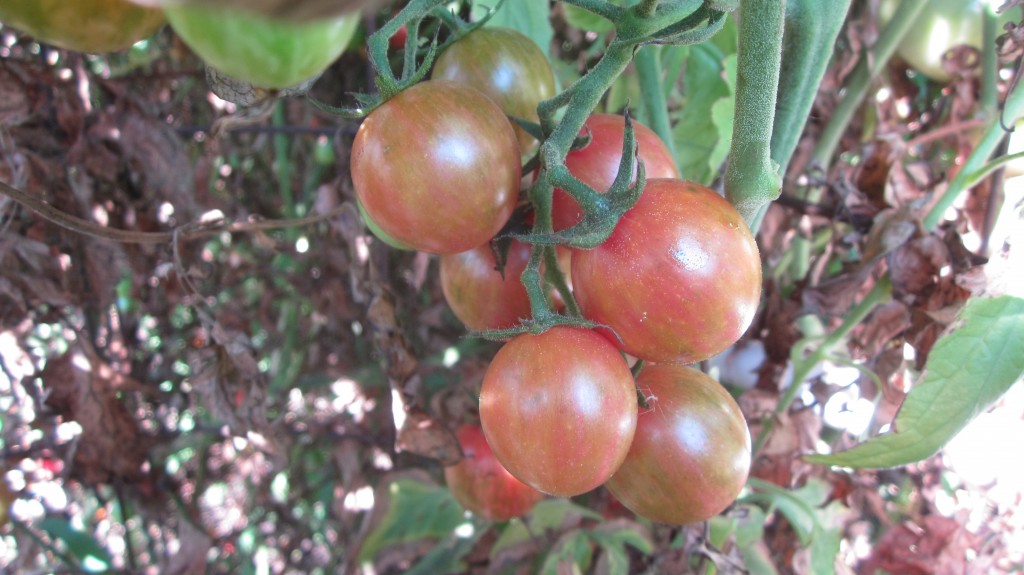
Tomorrow’s project: what to do with all the extra cherry tomatoes!
By the way, Gentle Readers, hop on over to The Prairie Homestead for their weekly blog hop. If this post of mine was helpful to you, than you’ll find plenty more over there to instruct, inspire, and delight! Tell them Amy sent you!



Several facts…
1. Bees are not disappearing due to GMO. Sorry. They are afflicted with a virus, one that seems to have gained speed due to pesticides eradicating other problems.
2. Your open pot and boiling jars/lids seemed to have taken some 2.5 to 3 hours- which is way longer than the short time used by others, which is a primary reason why the process is safe. Plenty of time to eradicate any potential pathogens.
Roy, I see that you are now writing about fowl. When you can’t beat ’em, join ’em, eh? 😉
The GMO crops that surround our place (for miles) are sprayed with pesticides, so indirectly I blame them for our struggles in keeping our bees alive. I also blame them for my hubby’s awful allergies, and my bad knee, and anything else that doesn’t seem to be going well. I’m just kidding, but I don’t like GMOs overmuch, you might have guessed. Sorry for being so unscientific!
I posted a couple more links on my vomitingchicken.com facebook page, Roy, about GMOS and the disappearing bees, if you’re interested in doing more reading on the matter.
Amy, this is my kind of post, I adore this type of thing and only wish I had the sort of harvest to be able can tomatoes. They look awesome.
I wish I could ship you a few jars, Anita-Clare. They’re lovely and I’m gonna have lots. Thanks for stopping by, birthday girl!
My husband has been canning for, oh, over 30 years and uses mainly the same method. Hasn’t poisoned anyone yet and my son and I are here to tell that tale. When we had a large garden in rural Arkansas he and I would work together (this was prior to having our son) and sometimes, to avoid the hot days of Arkansas, we would be canning at midnight and then would have to go to our day jobs. I miss being young! My favorite canning cookbook? I think it’s out of print, but here it is, and forgive the source “All About Pickling” by Ortho. Our copy is literally falling apart but – it is fantastic!
Thank you for the recommendation, Alana. I’m going to check that cookbook out!
Drama about bees, honey, Amazonians, and interruptions aside, I really enjoy the way you told this story about your tomatoes.
Thanks.
Thanks, Gary. I’m happy that you could follow it . . .I really went off on a few rabbit trails!
Loved this! Now I know what to do with any spare time (what’s that?) we might have!
There you go, Caro! Happy to help you out with that one! 😉
I loved this post–delightful, funny, dramatic, tense, astounding, incredible and with satisfaction at the end. Just as good as a novel. Boy, I wish I could taste your tomatoes in glass jars. (Not sure why you call it canned. After the shop-bought tinned ones?) I guess it’s the American way. Live the English call a vacuum cleaner a Hoover (after the first brand they saw.) 😉
Francene,
We’ve always thought it was humorous that this process is not called “jarring” instead of canning! Do you not do any canning of surplus garden veg there in England?
Oh Amy, you’ve done it again… made me wish I was you!!! I have never canned anything in all my life. The very idea overwhelms me somehow. Just your instruction #1 sounds like loads of work to me and it’s only the first step! Oh, but the rewards in those gorgeous jars! Your family is so lucky to have such a wonderful mom/wife/teacher, etc.!
Suerae, really, you are so sweet. Come visit and you can BE me and you may tire of it quicker than you think! Your comment made my day!
I have never canned but always wanted to. What I really want is an experienced canner to take me into their kitchen and let me help. I don’t think I really want to invest in the equipment and jars. I just want the experience of having done it. Can I come visit? Oh and awesome pix of Little Mack in the grasses.
Alana,
YES please make Nebraska a stop on your next roadtrip! I’d be happy to walk you through it. It’s time-consuming, but not difficult at all. This weekend, we’re making salsa and applesauce!
Woops, I meant Alessa–or Tammie?
Well done sister. I have loved Lucille’s method for many years! And that honey looks divine.
I figured you used it, too, Sister!
My daughter got mark down at the fair because she didn’t process her tomatoes for 80 minutes in water bath… Ugh!
Yikes, Debbie, how could there be any nutrients left after 80 minutes in boiling water? Gak!
Hello Amy, enjoyed the read! Are you aware that they are now putting on all lid boxes that the lids are good for only 1 yr? Also did you notice that the rubber on the lid is thinner than what it use to be. I figured if anyone noticed, you would. I think I may go to the tattler lids…yes I know they are expensive but wonderin’ if I trust the ball. Have you heard anything on this? Also, how long have you been canning like this (without a bath or pressure canner)? Where do you store your jars? Wow…never knew you could do this with no bath or pressure canning! I’m amazed.
great information. I see that Roy took you to task for saying you blame GMO’s for a lot of our problems. He did the same to me. He won’t change my mind. That is one of the things I love about Mexico, it has pushed back on GMO crops every year. The farmers do not want anything to do with them. Lucille sounds like the kind of person I like to have in my kitchen…..wise and willing to share old school systems. How did I miss this post back in 2013?
Dear Chef,
I don’t blame GMOs per se for all our problems, but even Roy would have to agree that the farming of them is RIFE with nasty side-effects. Here in the Midwest, where we are surrounded by GMO fields (literally), and spraying of chemicals to control fungus, disease, weeds, bugs, more bugs, resistant weeds, etc., happens constantly. The sprays kill and damage my (organic, heirloom) crops, kill my bees, make us sick (those days when you don’t know what’s wrong but your eyes hurt and you have a mild headache and you feel rotten), and moreover all that stuff washes into our waterways and even down into the Gulf of MExico!! So much potential damage to the environment through the modern farming techniques, which produce astounding quantities of corn and soybeans, but slowly but surely are destroying our environment. OH, I forgot that the huge acquifer underneath this section of the country, the Ogallalla Acquifer, is slowly but surely being drained by all the center pivot irrigation systems that water these huge fields of GMO crops. I’d sit down with Roy any day and argue with him over all this. I am intimately acquainted with GMO crops and the damage that the growing of them does to our beautiful Midwest. OH! I forgot the fact that the farmers are taking out all the windbreaks, to get ONE MORE ROW of GMO corn in (it’s profitable!) which will eventually lead to the topsoil being blown and/or eroded away. *phew* You got me on a soapbox, Chef. Time to move to Mexico, I guess. 🙁
A bit late on commenting on tomato canning, but I just found this post and wanted to share. I come from a long line of tomato canners, and we have water-bathed forever. Well, perhaps not quite forever, but you get the longevity idea! I wanted to note that in our method, we scald, peel, and chunk as do you, but we don’t do the extra 1/2-hour cooking in a kettle state prior to canning. We simply dump the chunked up pieces into the jars and process for 30 minutes. No poisoning yet to date after numberless years of great-grandma on down to this now-grandma! Just have to be sure of the seal as you also do, and out of years of habit, I always check the seal on any jars I bring up out of the fruit cellar as I use them during the winter months. Wanted to share a step-saver in case you might be interested!
Kristine, another word of common sense. Thank you! I appreciate the tip and I may even start incorporating that into my own tomato canning procedure. I really appreciate hearing from your experience.